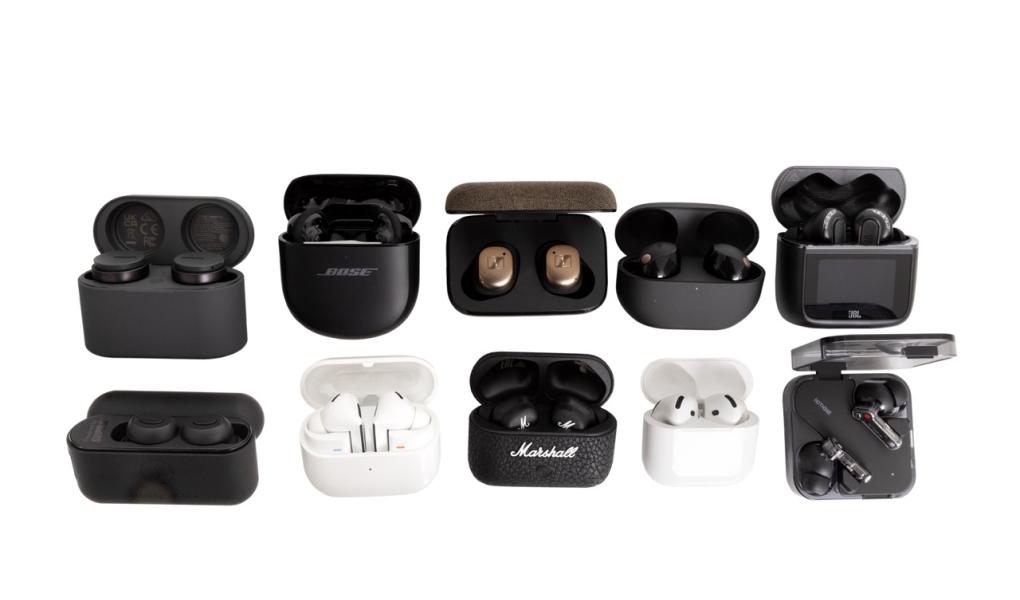Headphones today are used for much more than just enjoying music. We listen to audiobooks and podcasts, make phone calls, participate in video conferences, and block out ambient noise. There are now a variety of models and types of headphones to choose from, tailored to different needs and uses. Over-ear headphones are large models with ear cups, on-ear sit on top of the ear, while in-ear are the smallest models, where part of the earbud is inserted into the ear. Another term to know is True Wireless, which refers to headphones that communicate entirely wirelessly, both between the left and right earbud and between the earbuds and the playback device, usually via Bluetooth.
In recent years, the sound performance, user-friendliness, and battery life of small in-ear headphones have improved significantly, and they can now be seen in almost everyone’s ears.
But which in-ear headphones are the best? Testfakta commissioned the independent German laboratory Müller-BBM to test ten noise-cancelling in-ear headphones. Simon Gerke, who is responsible for the laboratory's sound tests, knows there are no shortcuts to achieving perfect sound.
– "Good headphones have a balanced sound profile without exaggerated bass or sharp high frequencies. The sound should be pleasant across various music genres. For small in-ear headphones, achieving powerful yet precise bass is particularly challenging."
[PDF]
Good sound quality overall
A panel evaluated the sound quality of the headphones by listening to classical music, rock/pop, and an audiobook. In the sound test, headphones from Sennheiser, Apple, and Sony received the highest scores, while Sound by Sweden showed some limitations in sound quality.
There were no significant differences in the headphones' individual sub-scores for music versus speech. Simon Gerke explains this by saying that speech has a narrower frequency range than music, making it easier to reproduce, even for small headphones.
– "So, if the headphones are good at reproducing music, they are often good at reproducing speech as well. Differences may arise if the voice sounds too sharp or muffled. Limitations in phone calls often stem from issues with data rates and frequency ranges of devices like mobile phones, rather than the sound quality of the headphones themselves."
The microphone's sound quality is especially crucial for those using headphones for phone calls. The test was conducted both with and without background noise. JBL, Apple, and Nothing effectively reduced background noise and delivered a clear audio profile, while Sennheiser and Samsung Galaxy picked up some background noise. Bose produced an artificial sound with some echo.
Reduced noise brings calm
Active Noise Cancellation (ANC) is a technology used in headphones to reduce unwanted ambient noise. It works by having built-in microphones that listen to surrounding sounds and generate their own counter-noise to cancel it. When it works well, users perceive the result as silence. Previously, this feature was primarily available in larger headphones. In recent years, the function has also been introduced in in-ear headphones, where it works very well, partly because they already block the ear canal.
The noise-cancelling capabilities of the headphones were tested both through acoustic measurements in the lab and by an expert panel. The expert panel perceived the noise reduction in JBL, Samsung, and Philips as very effective, and in technical tests, Sony ranked highest, with a significant noise reduction of 30 dB(A).
Silicone tips are generally considered crucial for optimal noise cancellation as they seal the ear canal, but it can still work without them.
– "Something that surprised me in the test was how effective the noise cancellation in the Apple AirPods 4 was, despite lacking silicone tips to seal the ear," says Simon Gerke.
User-friendliness and comfort
The laboratory also assessed the headphones' user-friendliness, how easy they are to set up and connect, swapping silicone tips, placing them in ears and in the charging case, the control functions of the headphones, and an overall impression of quality. Sennheiser received top marks for features like easy volume adjustment via touch, while Sound by Sweden scored low, partly for separate shutdown functions that caused confusion and for not pausing automatically when removed.
A panel also evaluated how comfortable the headphones were to wear and how easy they were to adjust.
Despite lacking silicone tips, Apple headphones were very easy to place in the ear. Even though they felt slightly loose, they didn’t fall out during the test. The fit of Sound by Sweden and Nothing headphones was also perceived as very comfortable. However, Philips headphones were the heaviest, with a protruding design that caused them to shift position. The surface texture of Marshall headphones was found to be uncomfortable as it occasionally irritated the skin.
Operating time varies greatly
The battery life of the earbuds varies significantly, from 4.5 hours for Apple to more than double, 11 hours, for Philips. The difference becomes even greater when accounting for the charging provided by the case. Here, Sound by Sweden stands out with a total of 70 hours of usage across 7 charges from the case. With Samsung, listening time ends after just 16.5 hours. Shorter listening times before charging are also seen with Sony (17h) and Apple (18h).
JBL performs best overall
The overall test winner is JBL headphones, which performed well in every test area, but many of the headphones in the test also performed well.
– "Overall, it can be said that all the tested headphones performed well in sound tests for both music and speech, except for Sound by Sweden. Some headphones have better microphone quality, others reduce surrounding noise very effectively, and some are, for example, almost waterproof," says Simon Gerke.
A good tip is to study the functions and features of the headphones carefully before purchasing, to determine which ones suit your needs and preferences best.





